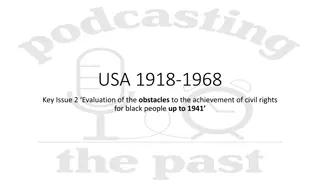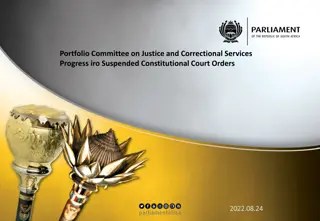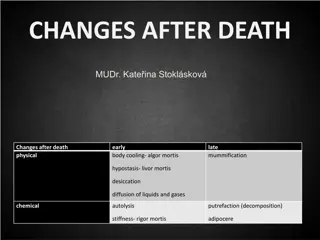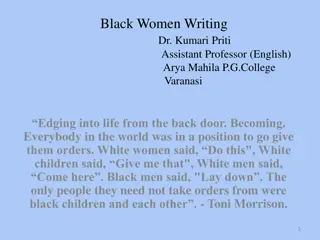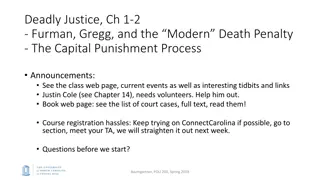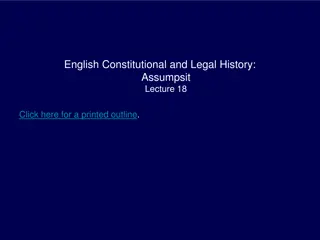The Impact of the Black Death on English Legal and Constitutional History
The Palmer thesis suggests that the Black Death in the fourteenth century influenced changes in law and constitution in England, leading to shifts in legal relations and societal structures. The Statute of Labourers of 1351 regulated wages and working conditions for various laborers, reflecting economic fluctuations. The population growth and wage rate changes during this period highlight the evolving landscape of English society.
Download Presentation

Please find below an Image/Link to download the presentation.
The content on the website is provided AS IS for your information and personal use only. It may not be sold, licensed, or shared on other websites without obtaining consent from the author.If you encounter any issues during the download, it is possible that the publisher has removed the file from their server.
You are allowed to download the files provided on this website for personal or commercial use, subject to the condition that they are used lawfully. All files are the property of their respective owners.
The content on the website is provided AS IS for your information and personal use only. It may not be sold, licensed, or shared on other websites without obtaining consent from the author.
E N D
Presentation Transcript
English Constitutional and Legal History: Order, Social Structure, and the Law Lecture 15 Click here for a printed outline.
English population 10861635 Domesday Book (1086): 275,000 tenants = ? 2 million. Population in 1300 = ??6 7 million. Poll Tax Returns (1377): 1,386,196 rate payers = ? 2.5 3 million. Population in 1410 = ?2.25 million. Population in 1541 = c. 2.774 million. Population in 1600 = c. 4 million. Population in 1635 = c. 5 million.
The Palmer thesis on the effects of the Black Death: Virtually every change in the law and constitution that occurred in the second half of the fourteenth century can be attributed to the Black Death. With some caution, we will accept his thesis that the action of trespass on the case began with an effort to get the traditional crafts and services, smiths, veterinarians, innkeepers, surgeons, millers, and the like, to fulfill, and perform up to, their customary obligations. Whether we should go further and attribute, let us say, the changing legal relations between the church and lay society, to the Black Death is a matter about which we may have more doubt. It depends on our positing that the elites who were in control had an overall vision of what they were trying to do, and for this we have no direct evidence.
Fluctuations in wage rates, 13001459 (scaled and put in terms of the price of wheat, Mats. p. VI 121) decade artisans agricultural labourers 1300 09 100 100 1310 19 109 121 1320 39 121 140 1340 59 136 148 1360 79 147 159 1380 99 190 235 1400 19 192 210 1420 39 182 200 1440 59 241 236
1351 Statute of Labourers (25 Edw. 3, stat. 2) First, that carters, ploughmen, drivers of the plough, shepherds, swineherds, dairymen, and all other servants, shall take the liveries and wages accustomed in the 20th year [1346] or four years before; so that in the countryside where wheat was wont to be given, they shall take for the bushel 10d, or wheat at the will of the giver until it be otherwise ordained. And that they be hired to serve by a whole year, or by other usual terms, and not by the day; and that none pay at haymaking time more than a penny a day; and a mower of meadows for the acre 5d, or 5d by the day; and reapers of corn in the first week of August 2d, and the second 3d, and so till the end of August, and less in the country where less was wont to be given, without meat or drink, or other courtesy to be demanded, given, or taken; and that all workmen bring openly in their hands to the merchant towns their tools, and they shall be hired there in a common place and not privately.
1351 Statute of Labourers (contd) The statute was remarkably sophisticated for its time. It contained an enforcement mechanism that was put into effect. Was it effective? The most widely accepted view is that it was initially successful in the sense that it kept wages lower than what they would have been otherwise, but that it ultimately was a failure.
What was the long-term economic effect of the Black Death? Normally the result of a substantial reduction in population will not be a substantial increase in wages. Both prices and wages will, of course, fluctuate chaotically as a new equilibrium is reached; fewer workers will, of course, mean that they are scarcer, but a general reduction in population will mean that there will be less demand for their services. What happened as a result of the Black Death suggests that the overall demand did not go down commensurate with the reduction in the supply of labor, and, hence, the wage to labor increased. Now for this to have happened, this must mean that the overall population and particularly the upper ranks of the income group which created more of the demand did not decline as much as did the workers. There is some indication that that was the case. For example, the population of religious houses did not go down as much as the overall population. Indeed, the first estimates of the mortality in the plague seriously underestimated its effect because they made use of those figures from religious houses. They have been corrected, painfully and quite uncertainly, on the basis of surviving rolls of manor courts.
Long-term economic effect of the Black Death (contd) It now seems fairly clear that the workers were hit harder by the plague than were the rich. Thus, the workers were able to demand higher wages. Since there were fewer workers, we cannot be sure that there was also a wealth transfer. It may just be that the rich were paying the same amount in aggregate, but since there were fewer workers, each worker got more, but there may also have been a wealth transfer as well.
The effect of the Statute of Labourers on the common law By the end of the century the courts were allowing a private action to be brought under the statute against those who had agreed to work but then had not performed the work. Would this action cover occupations not specifically mentioned in the statute? Perhaps it would cover everyone in a common calling . Would an action of trespass on the case cover failure to perform work when the statute was not mentioned in the writ? Probably not, but it may have had an effect on the long-term development of such an action.
The effect of the peasants revolt of 1381 After 1381 there was no serious attempt to enforce villein labor services. In the late 14th and 15th centuries, peasants by and large paid money rents for their lands. Their tenure was increasingly made more secure by the increasingly predictable customs of the manor courts. They transferred their land by entering a copy of the transfer in the manor court rolls. In the late 15th century the equity courts intervened to protect copyhold tenure. In the 16th century the common-law courts joined in as well. Copyhold land was different from freehold land, but the tenure was relatively secure.
The situation of the laborer in the 15th century Those who did not have enough land to live on, lived by their labor. That was, as it always has been, a hard and uncertain life, but the low levels of population in the 15th century made it less hard and less uncertain than it had been in previous centuries when population was higher. The squeeze began in the 16th century when population began to rise and prices began to rise even more dramatically. It may be bizarre to regard the 15th century, in so many ways such a gloomy century politically and culturally, as in some ways a golden age for very ordinary people, and the 16th century, in many ways a golden age culturally and perhaps politically, as a rather bad time for ordinary people, but that may, in fact, have been the case. One economic historian estimates that skilled laborers were better off in real terms in the 15th century than they were at any time before the 19th.
Distribution of income c. 1300 Rural Lay Earls Barons Clergy Archbishops Bishops Abbots Priors Rectors Vicars Urban p/a 400-1100 200-500 # families 140 Knights Esquires Lesser gentry Franklins Villein Tenants Cottars Merchants 20 200 5 40 2000 20 to 40 K Lesser Clergy Craftsmen 2 10 Journeymen 1 3 Apprentices Laborers Servants Marginals Laborers 1 2 Servants Marginals
Distribution of income c. 1500 If we estimated that 2% of the population had incomes or were in families that had incomes of more than 5 per annum in 1300, the percentage was probably closer to 10% in 1500. If we had difficulty in 1300 finding a contemporary term for those whose income and status placed them above the level of the peasant and below that of the knight, we find that a six-tier stratification of rural society has emerged by the end of the 15th century, and we may speak confidently of knights, esquires, gentlemen, yeomen, husbandmen, and laborers, and a four-tier stratification in urban society, merchants, master craftsmen, journeymen and laborers.
Statutory reflections of increased social stratification The Statute of Additions, 1 H. 5, c.5, requires the designation of the estate, degree or trade of everyone named as a defendant in a writ in a personal action or a record in a criminal action. Sumptuary Statute 37 Edw. 3, cc. 8 15 (1363) (see Mats., pp. VI 123 to 124). Sumptuary Statute, 22 Edw. 4, c.1 (1483) (see Mats., p. V 105).
Livery and maintenance. Bastard feudalism. Ordinance on livery (13 Ric. 2, s.3, c.1) (Mats., p. VI 125); statute on livery and maintenance (1 Henry 4, c. 7) (Mats., p. VI 125) Origins: money fiefs, indentures, feed retainers, general retainers Maintenance, the evil decried Stat. of 33 Edw. 1 (1305), the so-called Statute of Conspirators.
Livery and maintenance. Bastard feudalism (contd) Stat. 1 Ric. 2, c. 4 (1377) [c. 4] ITEM, It is ordained and established, and the King our Lord straitly commands That none of his counsellors, officers, or servants, nor any other person within the realm of England, of whatsoever estate or condition they be, shall from henceforth take nor sustain any quarrel by maintenance in the country, nor elsewhere, upon a grievous pain; that is to say, the said counsellors and the king s great officers, upon a pain which shall be ordained by the king himself, by the advice of the lords of his realm; and other less officers and servants of the king, as well in the Exchequer, and all his other courts and places, as of his own meiny [household], upon pain to lose their offices and services, and to be imprisoned, and then to be ransomed at the King s Will, every of them according to their degree, estate, and desert; and all other persons through the realm upon pain of imprisonment, and to be ransomed as the other aforesaid.
Livery and maintenance. Bastard feudalism (contd) Stat. 1 Ric. 2, c. 7 (1377) [c. 7] ITEM, Because that divers people of small revenue of land, rent, or other possessions, do make great retinue of people, as well of esquires as of others, in many parts of the realm, giving to them hats and other liveries, of one suit by year, taking of them the value of the same livery, or per case [in some situations] the double value, by such covenant and assurance, that every of them shall maintain other in all quarrels, be they reasonable or unreasonable, to the great mischief and oppression of the people; It is ordained and assented, That the statutes and ordinances made in such case before this time, be kept and duly executed; and moreover the King doth straitly defend [prohibit], that from henceforth no such livery be given to any man for maintenance of quarrels, nor other confederacies, upon pain of imprisonment and grievous forfeiture to the King; and the justices of assises shall diligently enquire of all them that gather them together in fraternities by such livery to do maintenance; and they which thereof shall be found guilty, shall be duly punished, every man after the quantity of his desert.
Livery and maintenance. Bastard feudalism (contd) Stat. 13 Ric. 2, s.3, c.1 (1390) , restricts livery of company (the military variety) to temporal peers of knights and esquires for life. Stat. 1 Henry 4, c. 7 (1399) , attempts to abolish livery for all except household servants. Stat. 1 Edw. 4 (1461) , attempts to prohibit livery except by royal grant. Stat. 8 Edw. 4. c.2 (1469) is an attempt a blanket prohibition, of livery, and it has a strong enforcement mechanism, but a proviso seems to exempt those retained for lawful service. Stat. 19 Henry VII, c. 14 (1504), pp. VI 129, may or may not close some of the loopholes, but seems to have been little more than a money-raiser. Most students of the question believe that the eventual end of the problem in the early years of the 16th century was more the result of social changes, particularly the decline of the nobility in this period, than of any statute.
Tudor social legislation The Beggars Act, 27 Hen 8, c. 25 (Mats., p. VI 125) (1536) draws a distinction between the impotent poor and the sturdy poor. Orders that the first be made to work, the second be taken care of with parish relief, and thunderously forbids open and common doles. The Statute of Artificers, 5 Eliz 1, c. 4 (Mats. pp. VI 130 to 132) (1563), abolishes all the previous legislation that had followed upon the Statute of Labourers, retains the notion that workers may not depart from service for which they have been retained, and puts the fixing of wages in the hands of local gentry. By the end of Elizabeth s reign the government was ready to institute a national system of poor relief. The Poor Relief Act, 39 Eliz 1, c 3 (Mats., pp. VI 132 to 133) (1598). Tudor charity and Statute of Charitable Uses, 42 Eliz 1, c. 4 (Mats., p. VI 133 to 135) (1601). The Jordan thesis.
Tudor social legislation (contd). The Jordan thesis. There was a very large increase in charitable giving over the course of the 16th century The types of charitable giving changed. These changes are attributable to the Reformation. But there was not a large increase in charitable giving over the course of the 16th century in real terms. The notion that one ought to spend one s charitable pound on institutions designed to effect long-term help for the poor is not a particularly Reformation idea. But that a remarkable number of charitable institutions were founded and survived is true, thanks in no small part to the legal protection afforded then by the Chancery and by the Elizabethan Statute of Charitable Uses.
Conclusion We argued in the first half of the course that feudal society was transformed by the legal changes of Henry II. We also argued, however, that neither Henry II nor those around him were conscious of what they were doing. The Black Death and the economic and social disruptions of the 14th century produce a new consciousness of the possibility of social change. Some of the changes still take place below the radar screen. The decline of villeinage falls into this category. But the later Middle Ages sees a number of examples of attempts to affect social conditions by means of changes in the law. Relatively few of them worked, at least in the way in which they were intended. One can, if one wishes, use the example of the later Middle Ages to support an argument that broad government regulation of the economy and society are futile. The legislation is, however, a good reflection of contemporary attitudes, at least among those who had the power to make statutes, and social change certainly did take place. Chaucer s England and Shakespeare s England are not the same place. The extent to which some, certainly not all, the differences between the two can be attributed to two centuries of conscious legal manipulation of the social structure is unknowable. I m inclined to think that some of them may be, but that may be my professional bias.






